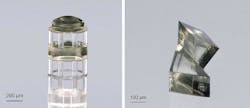High-precision additive-manufacturing developer Nanoscribe (Eggenstein-Leopoldshafen, Germany) has unveiled its new IP-n162 photoresin, a printing material with properties tailored for micro-optical elements such as microlenses, prisms, and complex freeform optics. The photoresin has a high refractive index combined with a high dispersion, the combination of which corresponds to a low Abbe number. These properties are particularly beneficial for 3D microfabrication of leading-edge micro-optical designs, including those without rotational symmetry, and compound 3D optical systems.
With a low absorption in the infrared region, the photoresin is the best choice for infrared micro-optics, according to Nanoscribe, but also for applications where low absorption losses are critical, such as optical communications, quantum technology, and photonics packaging. The novel printing material IP-n162 is specifically designed for additive manufacturing based on two-photon polymerization. The high-refractive-index material enables micro-optical designs with high shape accuracy.
Thanks to their optical properties, high-refractive-index polymers facilitate a variety of applications related to new technologies. For example, in optoelectronic applications, they enhance the visual properties of display devices, as well as camera and projector lenses. The availability of these materials for 3D microfabrication can help establish a new class of complex 3D micro-optical elements in much smaller sizes than possible with today’s classical technologies. Examples are microlenses in miniaturized imaging systems, endomicroscopy, and 3D sensing for augmented and virtual reality (AR/VR) applications.
High-refractive-index photoresin leads to great design flexibility
Nanoscribe explains that the main advantage of IP-n162 is its high refractive index of 1.62 at a wavelength of 589 nm. Compared to other Nanoscribe two-photon polymerization resins, the new printing material offers the highest refractive index.
“A high-refractive-index photoresin like IP-n162 gives the designer additional freedom to create lenses that are more powerful, thinner, less curved, more compact, and that can be also 3D-printed faster and cheaper,” notes Simon Thiele, project participant of the BMBF funded project PRINTOPTICS, and CTO of the spin-off company of the same name. In this project, Nanoscribe is partnering with the University of Stuttgart and the medical technology company Karl Storz in printing miniature optics on fibers for endoscopy applications.
“The most powerful design I realized with IP-n162 was a complex optical system consisting of two lenses with complete freeform surfaces to achieve a distortion-free image,” says Thiele. “A special feature is the integrated diffractive lens containing fine stair structures on the top of the lens to correct the color error. The high refractive index of IP-n162 helps to make these steps smaller and to reduce stray light.”
Low Abbe number enables achromatic micro-optics
The printing material exhibits a low Abbe number of 25, making it the Nanoscribe resin with the highest dispersion. The optical properties of structures printed with IP-n162 are close to optical polymers typically used in injection molding and can be compared to polycarbonates or polyesters.
One possible application of high dispersion is the fabrication of achromatic optical systems. By printing compound optics consisting of elements made of a lower refractive index next to a higher-refractive-index material such as IP-n162, achromatic optical systems can be additively manufactured on the microscale.
For more information, see https://www.nanoscribe.com/en/solutions/materials/ip-n162.

John Wallace | Senior Technical Editor (1998-2022)
John Wallace was with Laser Focus World for nearly 25 years, retiring in late June 2022. He obtained a bachelor's degree in mechanical engineering and physics at Rutgers University and a master's in optical engineering at the University of Rochester. Before becoming an editor, John worked as an engineer at RCA, Exxon, Eastman Kodak, and GCA Corporation.
